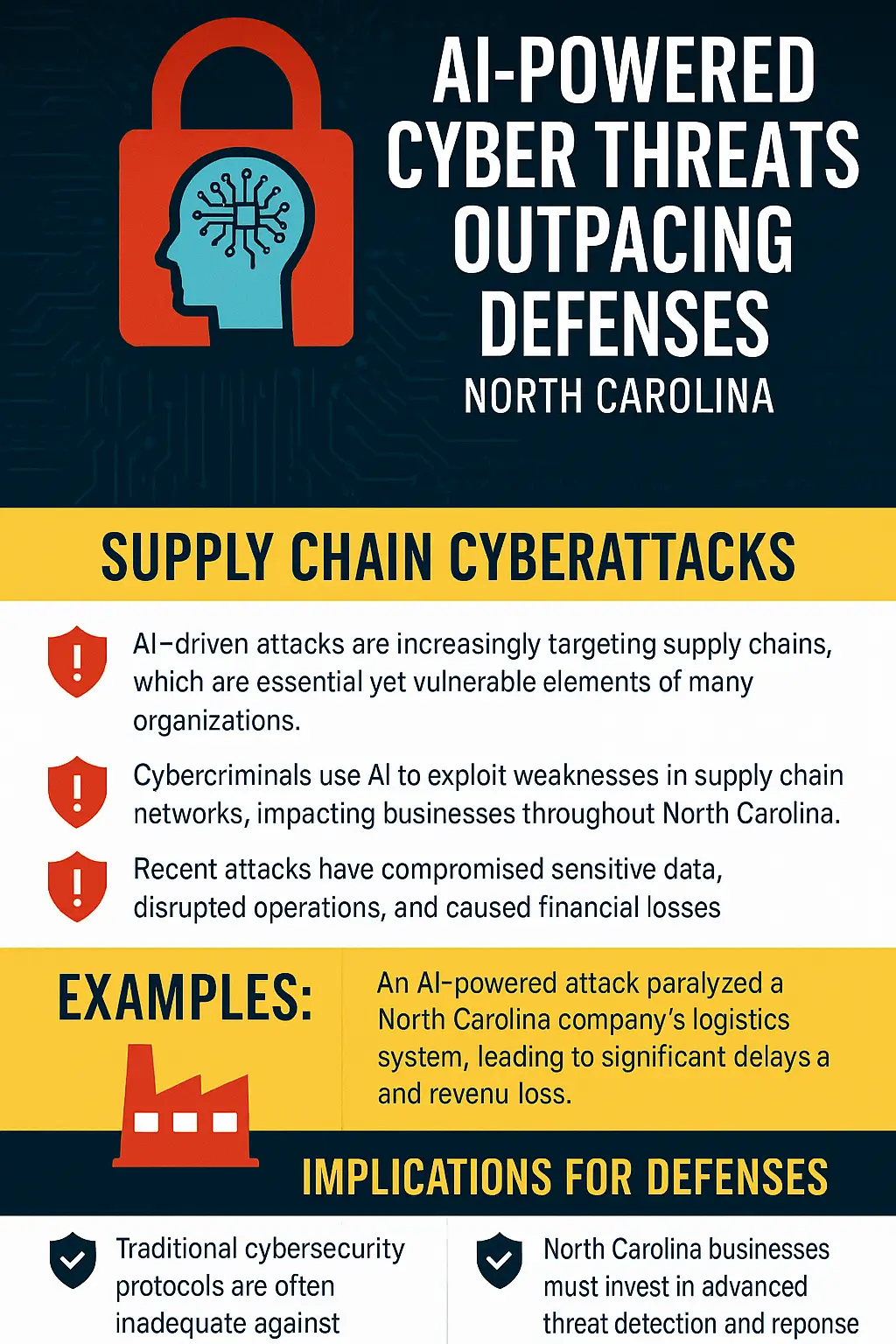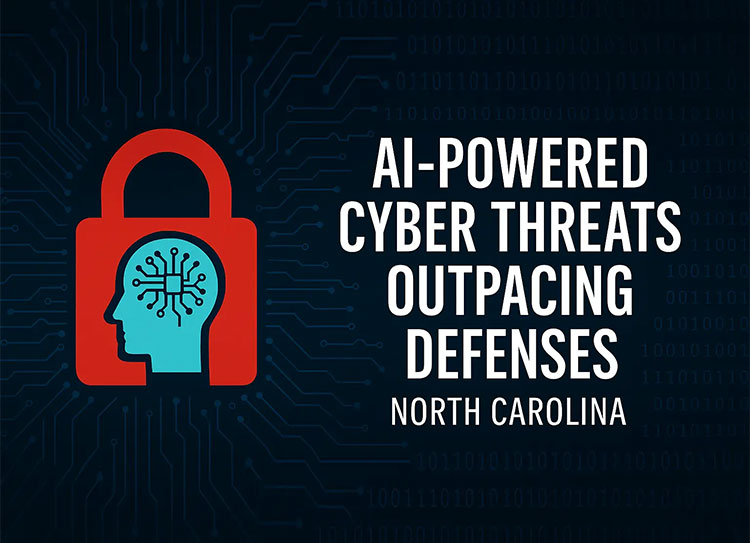AI-Powered Cyber Threats Outpacing Defenses
Why Supply Chain Cyberattacks Are the New Frontier
In the last few years, a striking shift has occurred in the cyber landscape: attackers are no longer content to probe single targets; instead, they are weaponizing artificial intelligence (AI) to infiltrate the very infrastructure that supports modern business operations. These AI-driven threats move faster, adapt smarter, and exploit systemic dependencies—making them especially potent when they target supply chains.
For organizations in North Carolina—whether universities, manufacturers, government agencies, or small businesses involved in global supply networks—the stakes are high. The question is: can defense systems evolve quickly enough?

The Rise of AI-Driven Cyber Attacks: A New Arms Race
From manual probes to machine-scale assaults
Historically, cyberattacks were slower, largely manual, and detectable by patterns (e.g., repeated login failures, malware signatures, anomalous traffic spikes). But AI changes the game. As described by the team at MixMode, AI-powered attacks can execute thousands of micro-actions simultaneously—credential probing, vulnerability scanning, phishing generation, and lateral movement—all within seconds.
These automated, adaptive agents can test defenses in real time: if a route is blocked, the AI pivots to alternative paths. The “attack window” compresses sharply. What previously might take hours or days to detect and respond to can now unfold in minutes—or quicker.
A 2025 survey (conducted via the Ponemon Institute and included in the MixMode “State of AI in Cybersecurity” report) found that 87 % of security professionals encountered AI-driven cyberattacks in the past year—a dramatic uptick from prior years.
Why traditional systems struggle
Legacy cybersecurity tools—signature-based detection, rule engines, static heuristics—are reaching their limits in the face of attackers who can morph their behavior, evade threshold triggers, and exploit blind spots.
Moreover, human defenders are overwhelmed by volume. Even if a security operations center (SOC) is staffed, sifting through countless alerts, triaging potential threats, and orchestrating responses in real time is a bottleneck. AI attackers exploit exactly that lag.
Because of these dynamics, many organizations are now pressing forward with predictive, real-time analytics, and “third-wave AI” systems that can adapt rather than merely detect.
Supply Chain Cyberattacks: The Weakest-Link Strategy
If you want to breach many targets, attack the link they all rely on. That is the logic driving supply chain cyberattacks—and when enhanced with AI, the approach becomes especially devastating.
Understanding supply chain risk
A “supply chain attack” refers broadly to a variety of techniques in which adversaries infiltrate a target not by attacking it directly, but by compromising one of its upstream or downstream dependencies—vendors, contractors, software libraries, APIs, firmware, logistics systems, or cloud providers. The attacker inserts malicious code, backdoors, compromised updates, or forged credentials in such a way that downstream organizations are exposed without direct initial contact.
Historically, some of the most notorious cyberattacks—such as SolarWinds—exploited this pattern. Once a trusted vendor or update mechanism is breached, adversaries can masquerade as legitimate traffic. The challenge is magnified when many organizations share common third-party dependencies.
From statistical and predictive research, using supply chain network features adds meaningful predictive power for anticipating cyber risk — i.e. organizations that look “safe” internally may actually have high exposure via their supplier network.
How AI supercharges supply chain attacks
AI amplifies every aspect of the supply chain attack paradigm. Below are key vectors by which AI is changing the threat calculus:
- Automated reconnaissance at scale
AI agents can crawl public and private repositories, vendor documentation, API schemas, leaked credential dumps, and codebases to map a vendor’s dependencies, security posture, and likely weak links—at machine speed. - Malicious code injection in updates
Attackers may weaponize software updates (patches, firmware, driver packages). Using AI, they can craft updates that look benign in functionality but carry hidden backdoors or data exfiltration triggers. One example is the “SolarTrade” logistics software compromise, in which attackers used AI to inject malicious code into a routine software update, disrupting operations and exfiltrating sensitive payment data. - Data poisoning and model corruption
In AI or ML-enabled supply chains—where forecasting, inventory, or logistic decisions depend on models—attackers can inject tainted training data or manipulated feedback loops to bias outcomes. The result can be sabotage or upstream decisions that degrade performance or open vulnerabilities. - Adaptive malware and polymorphism
Rather than a fixed payload, AI-assisted malware can mutate behavior to evade detection. It can observe the environment, recognize security tools, throttle its activity to avoid triggering alerts, or lie dormant until specific triggers. - API and microservice compromise
Modern supply chains lean heavily on APIs and microservices. AI can discover misconfigurations, API weaknesses, certificate vulnerabilities, and trust relationships across services, then exploit them in cascading fashion. - Open-source or repository attacks
Open-source code is a mainstay of modern software development, but it is also an attractive injection point. An attacker might compromise a library or model used by many downstream users. IBM warns of ransomware actors targeting open repositories like Hugging Face and GitHub to embed malicious payloads or corrupt dataset assumptions.
Because supply chains inherently involve trust, centralization, and many “blind spots,” the attacker’s job becomes far simpler when AI is added to the equation.
Case studies & trends
- The SecureWorld “2025 Supply Chain Threat Landscape” analysis predicted a 40 % surge in supply chain–related breaches compared to two years earlier, with digital logistics and vendor networks being prime targets.
- Risk Ledger’s blog highlights that supply chain attacks powered by AI are no longer hypothetical: attackers are rapidly locating weak nodes in a network and scaling compromise operations.
- In a report on “AI-Powered Attacks, Zero-Days, and Supply Chain Breaches,” SecureFrame flagged supply chain attacks as one of the top threats for 2025.
- Betanews echoed that supply chain vulnerabilities are increasingly exploited via third-party vendors in AI-enhanced campaigns.
Consider a hypothetical scenario in Charlotte, NC: A mid-sized precision-machining firm sources control software modules from a specialized vendor. That vendor, unknown to many of its clients, uses a third-party library for telemetry. If an attacker poisons or updates that shared library, they could gain control (or backdoor access) across multiple clients—including that firm in North Carolina—simultaneously.
Another illustration is in the healthcare sector. Suppose a medical device vendor distributes firmware updates to devices (e.g., infusion pumps). If that update system is compromised, attackers could subtly alter device behavior or install persistent monitoring. Because hospitals and practices often rely on that vendor’s trust chain, the risk cascades broadly.
Why AI-Powered Threats Are Outpacing Defenses
Looking at the current state, defenders are on the back foot. Here are the key dynamics:
- Speed and scale advantage
Attackers can launch reconnaissance, probing, and infiltration across thousands of nodes in minutes. Defenders can barely triage alerts in that time. The gap is widening. - Adaptive evasion
AI threats can adjust in real time to avoid rules, signatures, thresholds. Static defenses fall behind. - Blind spots in visibility
Many organizations don’t have full visibility into their vendor network, API dependencies, firmware channels, or third-party software flows. Attackers exploit those stealth corridors. - Resource constraints
Smaller organizations—common in North Carolina’s economic ecosystem—lack expansive security teams, advanced AI detection tools, or threat intelligence budgets, making them soft targets. - Legacy integration and talent gaps
Even when organizations adopt advanced tools, integrating them with legacy systems is nontrivial. Many security teams lack AI or data science expertise to tune, validate, or optimize sophisticated defenses. The 2025 MixMode report observed that 70 % of organizations cite difficulty integrating AI with legacy systems, while 59 % lack internal expertise to assess vendor claims. - Asymmetric risk profile
Attackers need only one entry point to compromise many downstream systems; defenders must secure every possible path. AI magnifies that asymmetry.
How Organizations (Including in North Carolina) Can Stay Ahead
No defense is perfect, but with the right posture, organizations can tilt the playing field. Below is a layered, strategic approach tailored for real-world constraints:
- Map and audit your supply chain ecosystem
- Vendor inventory & dependency mapping
Maintain a living map of all third-party vendors, software libraries, firmware sources, APIs, and cloud dependencies. Include subcontractors and secondary providers.
Use graph-based models to understand which vendors have high centrality or concentration risk. - Risk scoring and segmentation
Assign risk scores based on vendor access levels, patch hygiene, historical incident history, and connectivity. Prioritize continuous monitoring of high-risk nodes. - Enforce contractual security controls
Include clauses such as “right to audit,” minimum security standards, attestations, and incident escalation protocols in vendor agreements.
- Adopt AI-augmented defense capabilities
- Behavioral and anomaly detection (vs. signatures)
Use systems that learn baseline behavior and flag deviations—even if not previously known. - Third-wave AI / adaptive models
Explore platforms that support real-time adaptation, contextual awareness, and cross-domain correlation. - Threat intelligence integration
Feed newly observed TTPs (tactics, techniques, and procedures) into your detection models to close feedback loops.
- Zero-Trust and microsegmentation
- Treat every network, API, and service as potentially hostile.
- Segment networks so that compromise in one vendor link does not give lateral access across the enterprise.
- Use identity-based controls, least privilege, and just-in-time access to reduce long-lived credentials.
- Secure the update & software delivery pipeline
- Use cryptographic signatures and verification of firmware or software updates.
- Employ “split delivery” (partial offline validation) or multiple-layer validation.
- Monitor for anomalous changes in code or binary artifacts, using AI model integrity checks.
- For ML/AI systems, apply data poisoning detection schemes or use robust/defensive model training techniques.
- Continuous monitoring and incident response
- Instrument extensive logging, telemetry, and event correlation across networks, cloud, devices, and APIs.
- Automate response playbooks: isolate, revert, remediate, communicate.
- Run regular red-team / penetration testing exercises, including simulated supply chain attacks.
- Human factors, training & governance
- Train staff and vendors to understand AI-driven phishing, deepfakes, and social engineering tactics.
- Establish data governance, vendor oversight committees, and security review boards.
- Encourage cross-organization collaboration (e.g., public-private frameworks) for shared intelligence.
- Start small and scale
- Pilot in a critical sub-domain (e.g. vendor code repository) before expanding across the enterprise.
- Tune AI/defense models by feedback and real incident data; resist “one-size-fits-all” tools.
- Allocate budget for evolving threats rather than merely patching today’s holes.
For a manufacturing firm in Greensboro or a healthcare provider in Durham, these steps can provide meaningful resilience. Over time, smart automation and AI defense layers can relieve human burden while continuously closing attack windows.
A Call to Proactive Resilience
The cyber battlefield is changing. AI-Powered Cyber Threats and AI-Powered Cyber Attacks are no longer the stuff of sci-fi—they are now operational reality, and supply chain channels are rapidly becoming the most strategic vector of assault. The Rise of AI Driven Cyber Attack is a challenge but also an opportunity: defenders with foresight, agility, and layered strategy can stay ahead.
For organizations across North Carolina and beyond, this means embracing visibility, adopting AI-augmented defenses, embedding zero-trust principles, and cultivating a strong vendor security posture. The path won’t be easy—talent, resource constraints, and integration frictions will test us—but as adversaries move faster, our response must outpace them.

